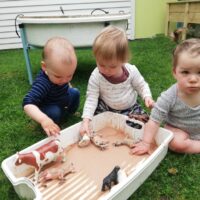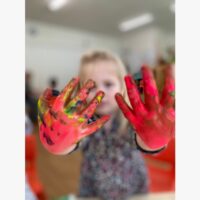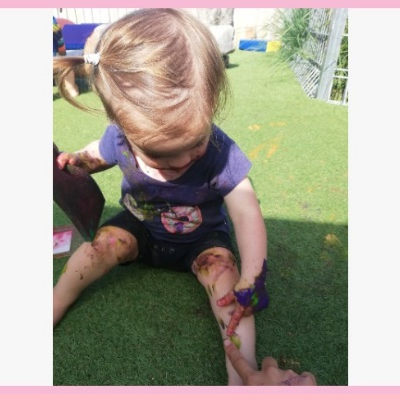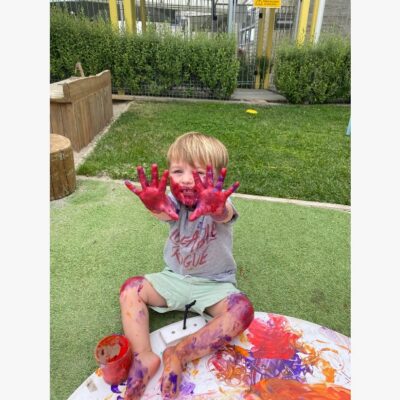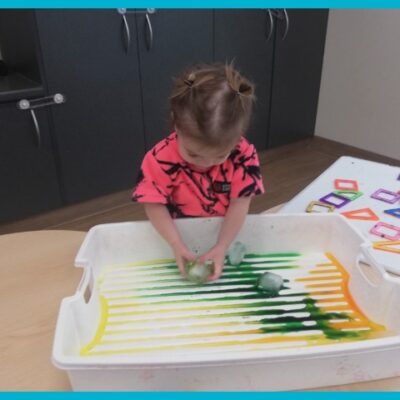Infants, toddlers, and young children are such sensory learners. Right from infancy babies are figuring out and making sense of the world around them.
They do this through using their senses, touch, taste, sight, hearing and smell. We all know very well that baby’s mouth nearly everything and find the smallest bits of fluff on the ground to pick up, but for them this is learning, how does it taste? How does it feel? Does it smell? What does it look like? Does it make noise?
This is how they learn, discover, and make sense of their world and what is happening for them. Children are naturally curious learners and explore their world with their whole bodies. Here at Elm Tree, we love to provide children with messy play and sensory play experiences right from in our Tui room through to our Fantail room. We believe in children learning through their senses in a safe way where children can “use all of the senses and physical abilities to make sense of the world” (Ministry of Education M.O.E, 2017, p.47).
Ideas of messy/sensory pay activities for infants, toddlers, and young children
1. Dinosaurs in Taste-Safe Mud
The messy play idea: Dinosaurs in Taste-Safe Mud by My Bored Toddler
In a nutshell: Realistically mushy squishy mud becomes the foundation for messy play. This game gives very young children and toddlers an opportunity to get messy, without the fear of too much real mud being consumed…
*What you need: *
- 2 cups of corn starch
- Water
- 1 cup of powdered hot chocolate mix or cocoa powder
- Assorted dinosaur toys
- Container
- Spoon
How you do it:
First, combine the corn flour and the cocoa powder in a bowl. You can choose how firm or how runny you want to make the messy mud by adding small amounts of water to the bowl. The general guideline calls for one cup of water to two cups of cornflour and one cup of cocoa powder, but there’s no rule. You can always firm it up a little bit with some more corn flour if the mixture becomes too runny. Finally, add some toy dinosaurs or farm animals and you’re set for muddy fun.

2. Fizzy Cloud Dough Experiment
The messy play idea: Fizzy Cloud Dough Experiment by Powerful Mothering
In a nutshell: This form of sensory and messy play will wire a whole bunch of new connections in the brain. It includes visual elements to stimulate awe followed by a sensory haven when little ones feel the fizzing on their skin. It’s gentle, it’s colourful, and easy to put together. This activity is best enjoyed outdoors or in a bathroom for easier cleaning.
What you need:
- 1 cup of flour
- 1 cup of baking soda
- 1/4 cup vegetable oil
- Oil-based or powder food colouring
- Vinegar
- A mixing bowl
- A tub for playing in
How you do it:
The method starts by creating sensory play dough (which is also safe for little ones who still put everything into their mouths). Push the play dough into the tub, and let your children explore with moulding and shaping it.
Then, add a bit of vinegar to the dough to bring the fizz out. The little ones will have a wonderful time grabbing the fizzing foam while the older children will have a kick out of adding the baking soda and watching the bubbles form.
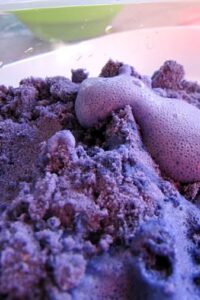
3. Balloon Painting
The messy play idea: Balloon Painting by Mosswood Connections
In a nutshell: This activity stimulates a marvellous sense of spatial awareness. It’s a new and exciting spin on painting, which is a favourite with most children. It adds an extra challenge and exercises some coordination skills too. Plus, the end result is so rewarding, children are sure to come away with a sense of accomplishment.
What you need:
- Balloons
- Child-friendly paint
- Cardboard or large sheets of paper (easel pads, for example)
- Large safety pins
- A funnel
How you do it:
Make sure you have a workspace that can take a decent amount of messy paint and paint splatters. Start by filling the balloons with paint. You can use a funnel for a cleaner result, or enjoy the sensory fun alongside the children and fill the balloons without a funnel.
Close the balloons’ opening at the top with a simple knot and use a safety pin to poke holes in the bottom of the balloon. Embrace any whoopsies that may occur as the children apply paint to the cardboard by squeezing it out of the balloons. If the balloon falls onto the cardboard, just embrace as the splatters as part of the creative process.
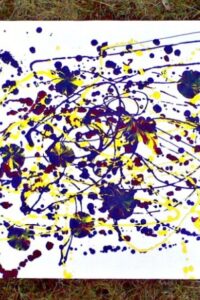
4. Under the Sea Sensory Jelly Adventure
The messy play idea: Under the Sea Jelly Sensory Adventure by Natural Beach Living
In a nutshell: Jelly. It’s sticky, squishy and super-duper squelchy! What’s not to love?
This underwater adventure also conceptualises the underwater world for slightly older children. The bonus is that it’s ideal for those little fingers that like to explore using their mouths.
What you need:
- Jelly mix (blue is best)
- Aquatic animal figurines
- A large container
How you do it:
Follow the instructions to make the jelly, but instead of using a glass dish, have the jelly set in the plastic container. After you pour the liquid into the container to set, add all the animals and the underwater creatures.
Once it’s set, let the messy play begin! If the children are very young, you’ll likely experience jelly splatters everywhere. Is this a good indication of how much fun is being had? Absolutely.
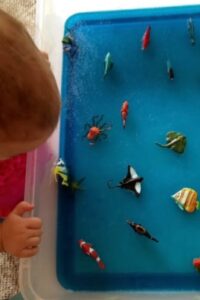
5. Colourful Melting Ice Cubes
The messy play idea: Colourful Ice Cube Melting Activity for Toddlers by Bambini Travel
In a nutshell: This activity allows young children, especially toddlers, to explore the different material states of water. It’s perfect for a hot summer’s day, as it demonstrates the power of the sun (for the benefit of older children) and it provides messy play fun that is cooling and captivating at the same time.
What you need:
- Ice cube trays
- Food colouring, or other non-toxic dye
- Water
- A large plastic container, or outdoor area
- Towels that can be stained
How you do it:
This is one of the simplest activities on the list, but it provides great messy fun for little ones. Simply fill the ice cube trays with water and add a few drops of food colouring. Once that’s done, add the colourful cubes to the plastic container and take it outside. Then, let the children climb in and enjoy themselves.
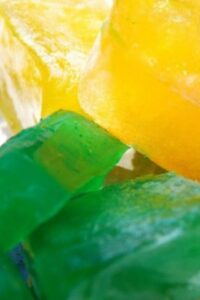
6. Window Painting with Shaving Foam
The messy play idea: Window Painting with Shaving Foam by Fun Learning For Kids
In a nutshell: Artsy, craftsy, messy fun. Letting artistic children near windows might put you on edge, but by swapping real paint for shaving foam, there’s nothing to worry about.
What you’ll need:
- Shaving cream
- Food colouring or washable tempera paint
- Muffin or cupcake tin
- Paintbrushes (optional)
How you do it:
Use each indent in the muffin tray for a different shade of shaving foam. Create your palette by squeezing some shaving foam into each indent and mixing in some paint or food colouring. Keep adding paint or colouring until the colour is where you want it. Voila! Let children apply the paint with their fingers or a paintbrush to the outside of the windows. When you’re done, it simply rinses off.
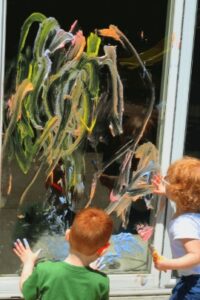
7. Painting with Trucks and Cars
The messy play idea: Painting with Trucks and Cars by My Bored Toddler
In a nutshell: Children drive their toy vehicles over a paper roadway — As they pass through slicks of paint, they leave colourful streaks in their tyre tracks.
What you need:
- Toys with wheels
- Large sheets of paper (butcher paper or easel pads are ideal)
- Washable paints
- Wipes
- Painting mat or washable tablecloth
- Painting smock or painting clothes
How you do it:
The butcher’s paper is your painting surface and roadway. Remember to do this activity in an area that is easy to clean up. Add blobs of paint in random areas on the paper and invite the young ones to use the trucks and cars to create tyre marks, spreading the paint into a vehicular masterpiece.
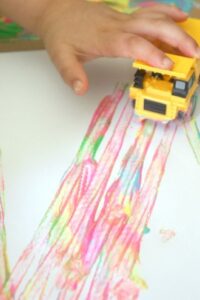
8. Finger Painting for Toddlers
The messy play idea: Finger Painting for Toddlers by My Bored Toddler
In a nutshell: From mixing different colours to creating dots, zig-zags, spider webs and even fingerprints, finger painting is always a messy experience. Some children get so immersed, they even start to paint on themselves.
What you need:
- Paper
- Washable poster paints
- Paper plates, or something else to create a paint palette
- Cleaning wipes
- Painting mat and painting clothes
How you do it:
It’s as self-explanatory as it sounds; set out the paints and the paper in a safe space and let the children enjoy it. This activity is about the motions rather than the outcome. Even older children can enjoy freedom in the fun without the pressures of a particular outcome.
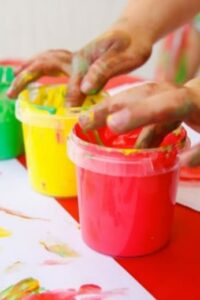
9. Homemade Gak Slime
The messy play idea: Homemade Gak in 5 Minutes by Living Well Mom
In a nutshell: When messy play doesn’t have to be quite so messy, a slimy gak recipe is perfect. This activity is for older children, because the slime is not suitable to put in one’s mouth.
What you need:
- School glue
- 1/2 cup room temperature water
- 1/4 cup hot water
- 1/2 teaspoon Borax
- Food colouring (optional)
How you do it:
Start by mixing the glue and the water in a container before stirring with a spoon. Add in the food colouring and the borax. The success of the slime depends entirely on how well the borax dissolved before it was mixed. Stir it into warm water and ensure there are no granules left behind. Keep stirring until it stiffens into a perfect slime. Did you know this gak can even bounce? Try it out.

10. Sensory Soup
The messy play idea: Sensory Soup by Happy Hooligans
In a nutshell: This outdoor activity can get messy and wet, as children explore the garden to make a pretend ‘soup’. It involves and grows different senses: Touch, smell, and noticing patterns and differences.
What you need:
- Herbs from the garden, or dried herbs
- Flowers, shells and stones
- Ladles and spoons
- Bowls
- Cups or scoops
- Scissors
- A large pot of water
How you do it:
Start by walking around the garden and introducing the young ones to the different herbs. Rub them on the skin to smell their scent. Allow the children to choose the herbs they like the most. Tearing, breaking, cutting and crumbling different plants develops fine motor skills. Allow each child to dish their herbs into their own bowls and observe as they mix up their own creative concoctions.
.
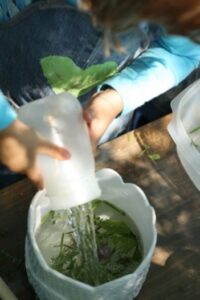
Benefits of messy/sensory play
- It Fosters Curiosity, Imagination and Exploration.
- It Encourages Communication and Language Development.
- It Practices Good Concentration and Nurtures Future Skills.
- It Promotes Physical Development.
- It Supports the Ability to Play Independently.
Arohanui,
Nicola and The Elm Tree Team
